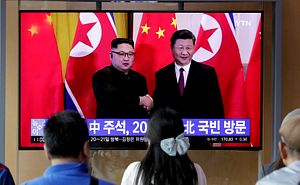Earlier this week China’s Foreign Minister Wang Yi traveled to meet with his counterpart in Pyongyang to, some have said, potentially lay the groundwork for another future exchange between China’s Xi Jinping and North Korea’s Kim Jong Un. Wang last visited the neighboring country in May 2018, just ahead of the summit between Kim and Trump in Singapore, while this most recent trip comes amid signs of impatience and a possible impasse in discussions between Pyongyang and Washington. While the intrigue of triangular dynamics tends to dominate the news cycle, it is worthwhile to review how ties between Beijing and Pyongyang have shifted of late, especially as the two mark the 70th anniversary of the establishment of formal diplomatic relations.
During Xi’s first five-year term (2013-2018), the historically warm friendship between Beijing and Pyongyang appeared to cool, particularly as the North’s young Kim continued to ramp up nuclear and missile testing. China, though still committed to ensuring stability along its northeast border and concerned with nuclear proliferation, signed on to a series of increasingly harsh and constricting United Nations sanctions that squeezed North Korea’s already isolated economy.
The chill between the two Northeast Asian countries began to dissipate in early 2018 when Kim and Xi met secretly for the first time in Beijing. The meeting was part of a diplomatic flurry surrounding North Korean denuclearization. The March 2018 trip to Beijing was also Kim Jong Un’s first trip abroad since coming to power in 2011 (he has since traveled to China an additional three times, South Korea twice, as well as Singapore, Vietnam, and Russia). Xi reciprocated by making his own state visit to Pyongyang in June 2019, marking the first visit of a sitting Chinese leader to North Korea in more than 14 years.
Despite the sanctions in place, China remains North Korea’s primary economic lifeline. Sanctions enforcement has been lax and vested parties have been able to identify loopholes to evade them. Nevertheless, annual China-North Korea trade, which had been on the rise between 2004 and 2014, plummeted over 2016, 2017, and 2018 under international sanctions. However, in the past year and a half, economic ties have mirrored the diplomatic rapprochement. The Chinese Ministry of Commerce said that total two-way trade between January and June 2019 rose to $1.25 billion, up around 14 percent from the same period the previous year.
North Korea has also been exporting a higher volume of paintings and wigs to its neighbor, examples of remaining goods that can still be traded under the existing sanctions regime. According to the Korea Trade and Investment Promotion Agency, exports of wigs and other products to China soared almost 160 percent in 2018.
In April, a bridge over the Yalu River connecting the city of Ji’an in China’s Jilin province and North Korea’s Manpho finally opened after three years of delays in a bid to boost economic exchanges. Separately, Xi Jinping pledged to fund construction related costs for facilities to serve another completed but unopened bridge that links Dandong and Sinuiju. The Chinese city of Dandong is a major trade hub for the two countries. At the 2019 G-20 Summit in Japan, Xi is said to have encouraged Trump to be flexible and ease sanctions, no doubt out of China’s own interest to play a significant role in North Korea’s opening up and development, particularly under the mounting pressure of the U.S.-China trade war.
An Gang, a research fellow at the Center for International Strategy and Security, writes that “Xi’s visit to the DPRK elevated the joint attempt to bring back the special-neighbor relationship to the highest level.” On Wang’s trip, the foreign minister “affirmed that China will always stand on the road as comrades and friends,” according to North Korea’s KCNA. Economic dynamics are likely as much a driving force behind improved China-North Korea relations as the political, diplomatic jockeying for both China and North Korea when facing off with the United States. If current trends continue, we can expect a steadier build up of economic exchanges and equal parts flowery and carefully crafted rhetoric about the strong state of the bilateral relationship. Still, this embrace is likely more mutually instrumental than motivated by shared values and principles once heralded in the past.

































